This is a companion article to a previous post “5 Vital Clues You Missed in the 1900 US Census.” Each article explores not-so-obvious clues in the 1900 US Census. They can be read in any order.

Consider this an advanced course in reading the 1900 US Census.
It starts simple enough, with a 14-year-old girl named Helen Marcus. We didn’t know much about her at first, just that she was someone’s great-grandma. (This was back in my Ancestry.com days.)
So we started researching her life, and right away found her in the 1900 US Census. And that’s where we discovered something interesting. Well, 5 very interesting things to be exact.
And quickly, the research went from looking at just 1 page in the 1900 census to looking at 4 pages of that census.
But I’m getting ahead of myself.
Helen Marcus in the 1900 US Census
Let’s go back to Helen and where we found her in the 1900 US Census (she’s highlighted in green):
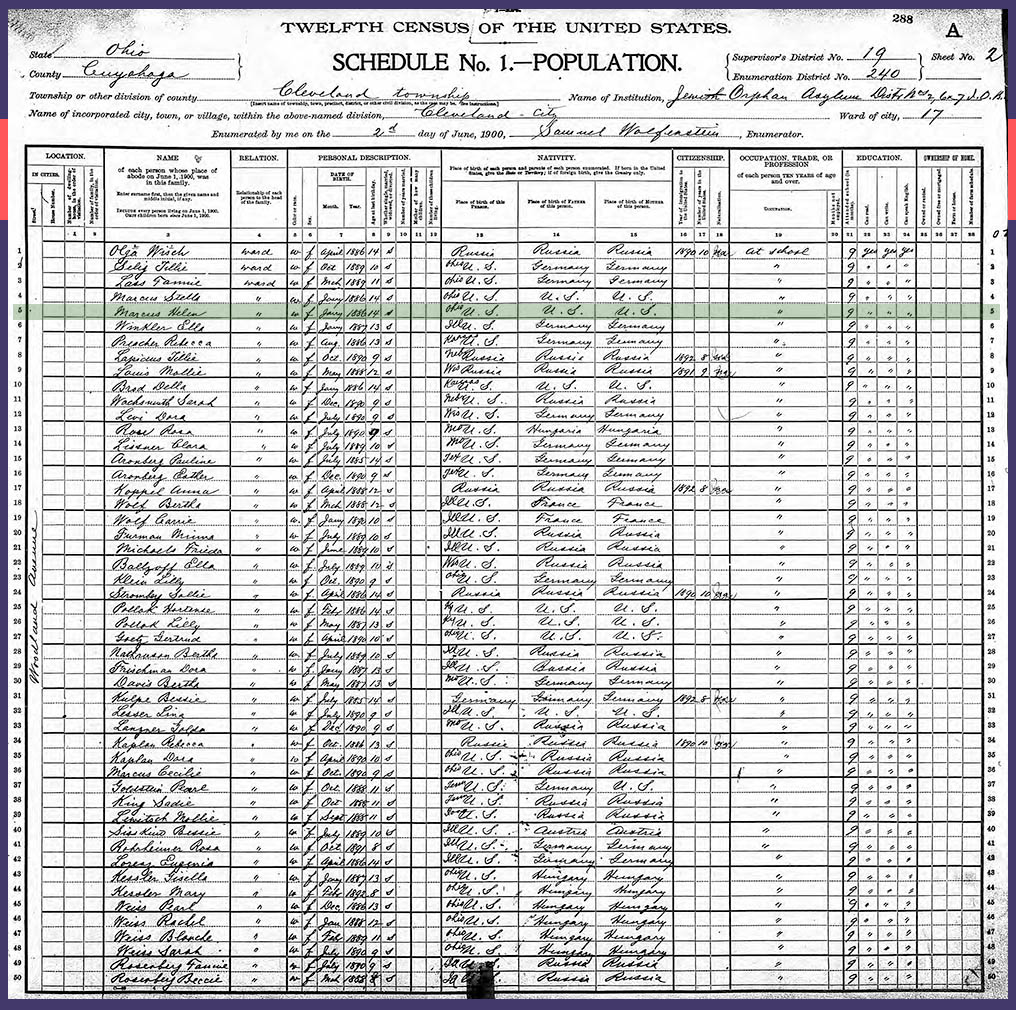
That’s a lot of info for a small screen, so let’s zoom in on just the portion with Helen in it. (And, of course, I’ve sliced and spliced portions of the census so that we can read it better.)
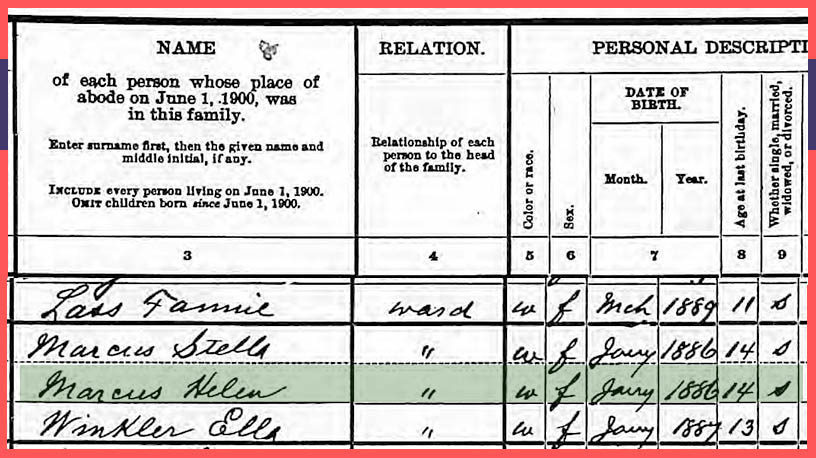
So here we have Helen Marcus. Move over to Column 5, and we learn she’s White. In Column 6, that she is indeed Female. Cols. 7 & 8 let us know she’s 14 years old and was born January 1886. And column 9 tells us that she is, thankfully, still Single.
But let’s go back to Column 4. This gives each person’s relationship to the Head of the Household/family. Usually the House Head in 1900 was the father/husband of the family. The realtionship stated for Helen is — ditto marks. So, following those up, we learn her relationship to the Head of House is Ward.
Ward? Ward of the state? Ward of the court? Ward/patient of a hospital (and what kind of hospital)? Living with someone who is not her parent?
It’s an interesting clue and question. And we’ll get to the answer in a couple minutes. But first…
Clue #1 — Relationships that aren’t obviously stated
Take a look at the girl directly above Helen. You probably already noticed this, but her name is Stella Marcus. Helen Marcus. Stella Marcus. Are the sisters? It’s a good guess.
Now, move your eyes right to column 7 and notice Stella’s birth day — January 1886. Look down one row to Helen’s birthday. It’s the same.
Two girls. Same age. Same last name. Same birth month and year.
Twins?
That was my guess, too. (I know from other research that they are, indeed twin sisters. And, fun fact, they married (non-twin) brothers on the same day in 1908.)
The lesson for your tree:
Sometimes relationships aren’t obviously stated in the census. It’s wonderful when the census tells us that John Smith is living with his wife, his 6 children, his mother-in-law, and his sister.
Sometimes, though, relationships aren’t super obvious. Helen and Stella are one example.
Walt Disney is another example.
In the 1930 census, Walt and his wife are living next door to Walt’s brother Roy Disney. Both Walt and Roy are listed as the Head of their families. But, since we know a little about the family, we’re able to identify both brothers.
You may not know the names of someone’s sibling, however, I recommend looking at a family’s neighbors and seeing if there are any last names you recognize. Families sometimes live in the same neighborhood.
A third example is servants.
After the Civil War, some formerly enslaved individuals became servants in their former “owners” household. So, in some cases, if you discover an African-American ancestor working as a servant for a white family in the 30-40 years after the Civil War (so 1870-1900), you may have discovered the family he/she was enslaved by.
Now this is not 100% true in every case. Researching into slavery times is complex and advanced. However, such a situation could offer a clue to keep in the back of your mind.
Clue #2 — People living at “institutions” in the 1900 US Census
Well, let’s get back to our story. Helen has a twin sister named Stella. But what’s this about them being Wards of whoever is the head of the household.
For that, we need to look up.
No, I’m not saying we need divine help here. I mean, look up to the top of the census page.
The top of every 1900 Census page gives the city, county, and state where the people on the page lived. In this case, Cleveland, Ohio. But directly under the word Population, there’s an often-overlook line — Name of Institution.
Here’s the top portion of Helen and Stella’s 1900 Census page. And it answers our question about them being wards:

These two girls, as well as everyone else listed on the census page, were wards of the Jewish Orphan Asylum in Cleveland, Ohio.
Now, I know what you’re thinking, “Asylum! Oh my goodness.”
Before we start mentally adding the word “insane” before “asylum,” remember that asylum‘s actual definition is along the lines of shelter, sanctuary, place of safety. And back in the day, asylum could refer to a number of different kinds of institutions (which also has lots of negative connotations, doesn’t it. Boy, the Victorian Era really messed with some words, didn’t it…)
Institutions, according to the census, could really be any location where people live but is not a proper “home.” I’ve seen Navy ships (so a counting of the sailors on board), Poor/Work farms, and hospitals all listed as Institutions in census.
What to do if your ancestor lived in an “Institution” in the 1900 US Census
Google it. (Or use Bing or Alta Vista or Ask Jeeves or whatever search engine you want to use. I’m not a tyrant, I won’t force you to use the Google.)
A search for “Jewish Orphan Asylum Cleveland” brought up several web pages about the “Institution” where Stella and Helen lived. And I discovered it was an orphanage for Jewish children, most orphans who had come from Eastern Europe.
The Cleveland Jewish History website has several pictures of the Jewish Orphan Asylum around the time period the Marcus children lived there. Here’s a pic of the main building, taken around 1900:
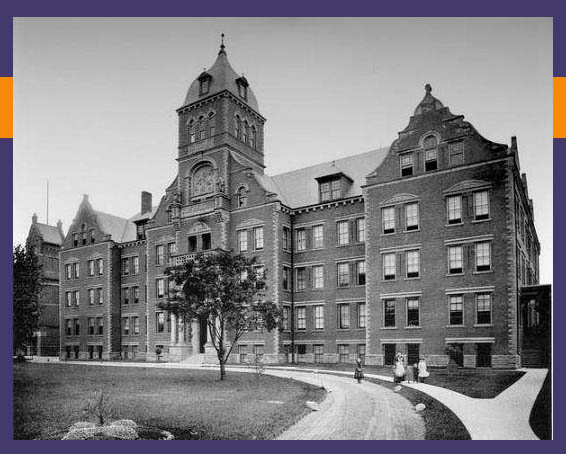
In the pic (below) from the 1920s, you can see that the school buildings were set back from the road (the main school building is on the right side):
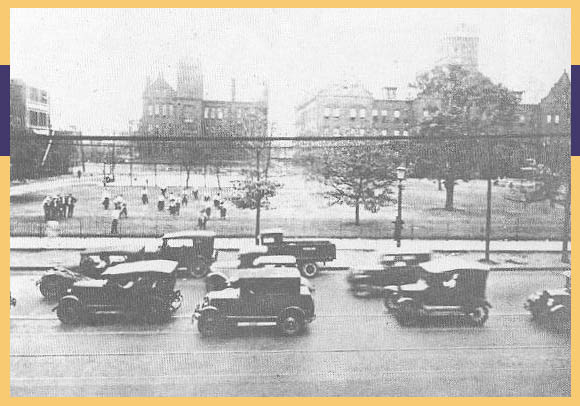
Let’s talk about that road for a moment. It’s called Woodland Road. How do I know? ‘Cause the 1900 Census told me. Don’t believe me? Here’s proof:
Clue #3 — Your ancestor’s actual address is in the 1900 US Census

All the way over on the very left side of each 1900 US Census page, under the LOCATION heading, there’s a column labeled “Street.”
In the case of the Jewish Orphan Asylum, the census tells us it was on Woodland Avenue.
Right next to the Street column is one labeled “House Number” (see the red arrow). This would be the number part of the location’s address. (As in the “1234” part in the address “1234 Main Street”.)
Now, the Jewish Orphan Asylum doesn’t have a listed House Number. But . . . odds are your ancestors do have a house number shown in their 1900 Census.
And, if the house still stands and the street still has the same name and numbering system, then you can Google that address and sometimes get a satellite and/or street view of the location. How so cool is that? (As my 3 year old sometimes asks.)
Let’s see a Google Maps search in action
The image below is where the Jewish Orphan Asylum was located in 1900 (the buildings from the pics above are no longer standing, as far as I’ve discovered):
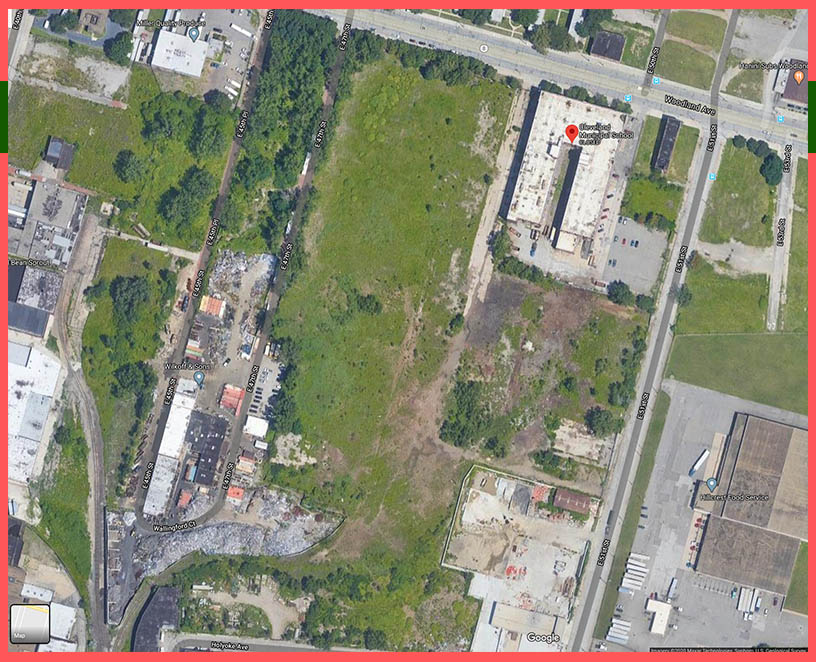
From my previous Google search, I learned that the asylum was at the corner of Woodland Ave and present-day E 51st Street in Cleveland, Ohio. So I brought up Google Maps and found this image.
The upside-down, U-shaped building near Woodland Ave (at the image’s top) is a school. Street view shows that it’s NOT the main school building from the old-time photos above, which isn’t surprising since one of those photos shows that the asylum’s buildings sat back from the road.
I do think, however, that much of the green areas to the left and bottom of the current school building were part of the original Jewish Orphan Asylum grounds.
You can do this exact same thing with your family. Find their address in the 1900 US Census (and be sure to look at the top of the census page to get the city and state). Then plug it into an online map site, switch over to satellite view or street view, and see if their house is still there. Dang, I love modern technology!
Note: Street names and house numbers can change. Buildings can be demolished. So this exercise may not produce their actual house or living location. But it’s worth looking for, just in case.
Clue #4 — Families can be split across multiple pages
Notice the gender of all the orphans listed in this portion of the census (look at Column 6):

They’re all female. In fact, all of the orphans listed on this page are female. (Go back to the image of the full census page at the top of this article to see for yourself.)
What does that suggest?
- Maybe the Jewish Orphan Asylum was a girls-only facility.
- Perhaps the orphans were grouped by gender — all the females listed together, all the males listed together.
In this case, the later is true. 4 pages after Helen and Stella’s page, all the male orphans begin to be listed.
Once I found this, I wondered whether there were any male Marcus children living at the Jewish Orphan Asylum. So I looked at every male name on the census pages for the asylum. And, on the very last row of a fairly dark page, I discovered:

A 12-year-old boy named Henry or Harry Marcus.
And because his name was on the very last row of this census page, I clicked to the next page. On the top row of that page was:

10-year-old Sidney Marcus.
At this point I didn’t know for certain, but I strongly suspected these two boys were siblings of Helen and Stella. (Later research verified that they are.)
If I hadn’t have taken the time to look through the rest of the orphans listed at the Jewish Orphan Asylum, I wouldn’t have discovered these two siblings.
Remember this for your family tree:
Families are often split across two census pages.
When the census taker filled out the form, s/he started at the top and filled in every row, then moved on to the next page. They weren’t concerned with keeping families grouped together on the same page.
So, if your family is the last family on their census page, click over to the next page to make sure you’re not missing any family members.
Conversely, if you discover an ancestor at the top of a census page, and he/she is not the Head of the Household, odds are the rest of the family is on the previous page. So click back one page to get a peek at the entire family (they’ll be at the bottom of that previous page).
Note: When you’re viewing a census image on Ancestry.com, arrows on the right and left side of the screen allow you to move forward and backward through other census pages. And they’re shown in order (unless there’s some kind of error.)
Clue #5 — Unexpected clues can be gold mines
The Marcus children’s 1900 US Census offers two unexpected clues.
- They are Jewish
- They are orphans
They are unexpected clues because the 1900 US Census didn’t ask questions about ethnicity or about being orphans.
Let’s explore these unusual 1900 Census clues one at a time.
The Jewish clue
To be in the Jewish Orphan Asylum, they had to be Jewish. Which seems fairly obvious. But here’s the interesting thing…
Helen Marcus was the direct maternal great-grandmother of the woman (we’ll call her Megan) whose tree we were researching. In other words, Helen was Megan’s mother’s mother’s mother. A direct female line from Megan to Helen.
Traditionally, Jewish ethnicity follows the female line. Thus, if your mother is Jewish, then you are Jewish. And following this logic, then Megan is Jewish.
However, Megan didn’t know she had any Jewish heritage. She considered herself Italian-American (from her father’s side).
So, in this case, discovering that Helen was Jewish gave Megan an entirely new ethic identity.
The orphan clue
We’re finally getting to the question that I know has been burning since you first read “Jewish Orphan Asylum.” They were orphans!?!? What happened to their parents?
Well, I’m glad you’ve been itching to know, ’cause that means you’re curious. And I’m all about being curious!
Cutting (through lots of research) to the chase, the answer is: No, the Marcus children were not orphans. Their mother did die sometime in the last 1890s. However, in 1900, their father, Nathan, lived in Cincinnati, Ohio:
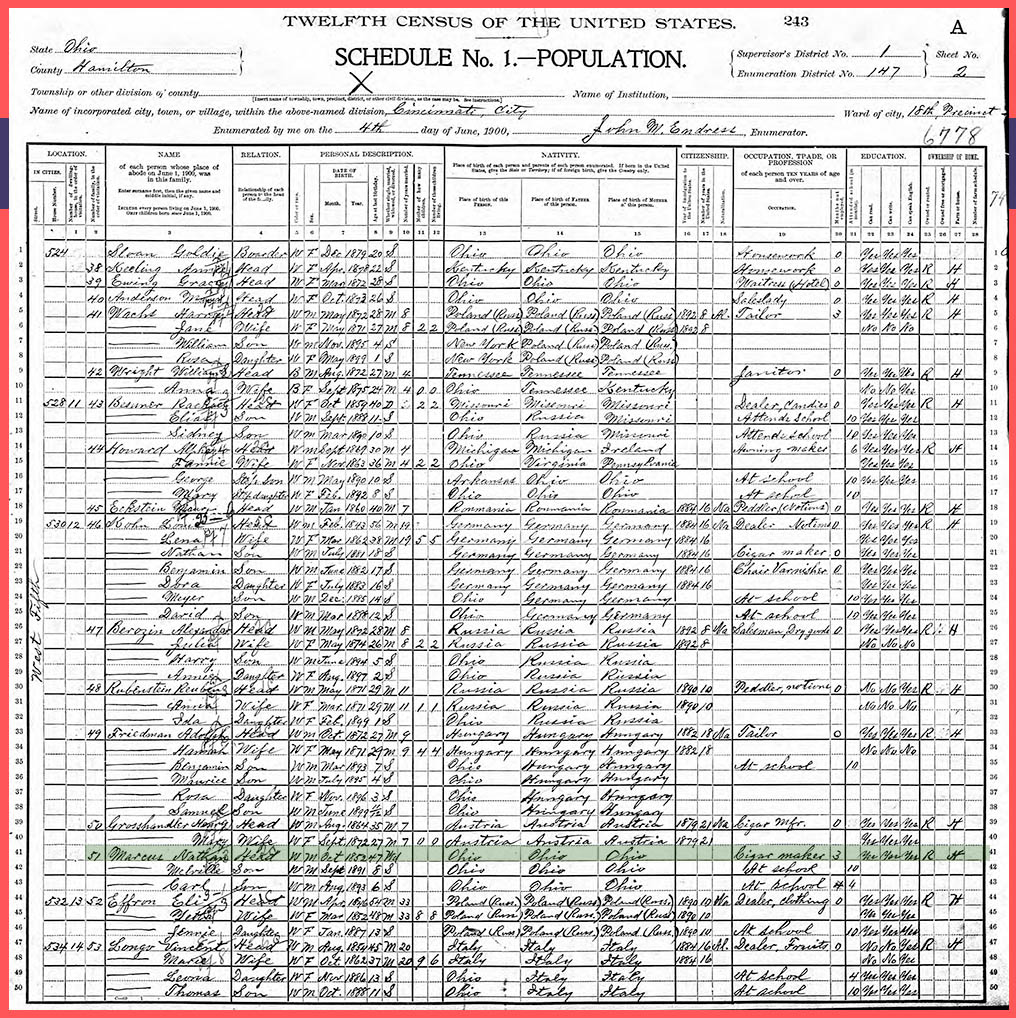
Here’s a closer look at his household:
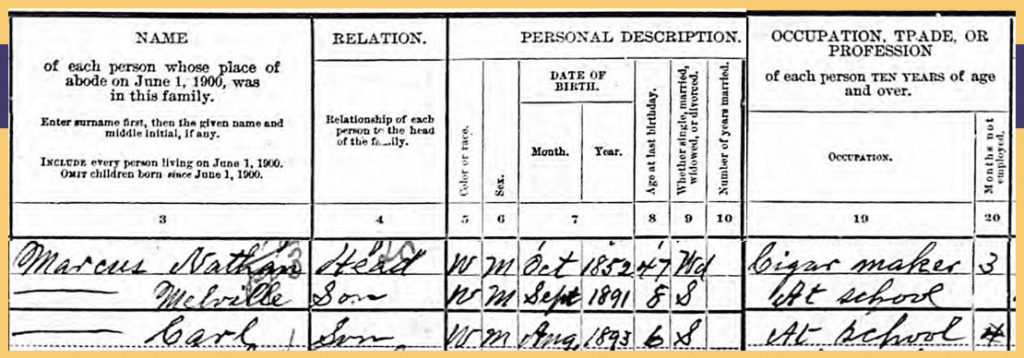
OK, so several things going on here. The most noticeable is that Nathan has two additional children — 8-year-old Melville and 6-year-old Carl — living with him. That means there at 6 Marcus children, not 4.
Column 8 tells us Nathan is 47, and in Column 9 we discover he is a Widower (Wd). So by April 1900, his wife has passed. Continue looking right to Column 19 (I’ve again sliced and spliced this census image), where his occupation is Cigar Maker. Column 20 informs that he’s been out of work for 3 months.
Creating a family timeline
My other 1900 Census article discusses how birth years in the 1900 US Census can create a timeline for a family, which helps tell their story. So, taking birth info from all 4 of the Marcus family census pages, here’s a timeline for the Marcus family:
- October 1852 — Father Nathan Marcus is born in Ohio
- January 1886 — Twins Helen and Stella are born in Ohio (which may suggest their parents married in Ohio in the early 1880s)
- October 1887 — Son Harry/Henry is born (likely in Ohio)
- September 1889 — Son Sidney is born (likely in Ohio)
- September 1891 — Son Melville is born in Ohio
- August 1893 — Son Carl is born in Ohio
- Between August 1893-April 1900 — Nathan’s wife dies
- April 1900 — 4 of the Marcus children are living in Cleveland’s Jewish Orphan Asylum, Nathan and 2 youngest live in Cincinnati
So why are some of the Marcus children living in an orphanage 250 miles away from their father?
Well, from my research into the asylum, it wasn’t unheard of for children to live there even though they weren’t technically orphans. The asylum offered opportunities for schooling, training, and association with other Jewish children.
Furthermore, I suspect that Nathan fell on difficult financial times. In April 1900, he had been out of work for 3 months. And who knows how much a Cigar Maker made in 1900. Could he have supported and raised 6 children with that occupation and no wife?
By 1910, Sidney was again living with his father, so that suggests the Marcus children’s stay at the Jewish Orphan Asylum was temporary.
Follow every clue in your tree
The main takeaway from this final section is to follow unexpected clues and see where they lead you.
When we started researching Helen Marcus, we had no idea we’d discover her living in the Jewish Orphan Asylum. But we grabbed onto these two strange clues, and discovered some mighty interesting things about this family.
You can, too, with some curiosity, timeline analysis, Google searches, and any other research tool at your disposal.
In fact, I’ve created a free worksheet that walks you step-by-step through pulling stories and information out of the 1900 US Census. Stories like those we’ve uncovered in this article, as well as many many, more!
It’s the same process I’d walk you through if you and I can could sit down together 1:1 and go through your family’s 1900 census information. So download this free worksheet and don’t ever miss a clue about your family!

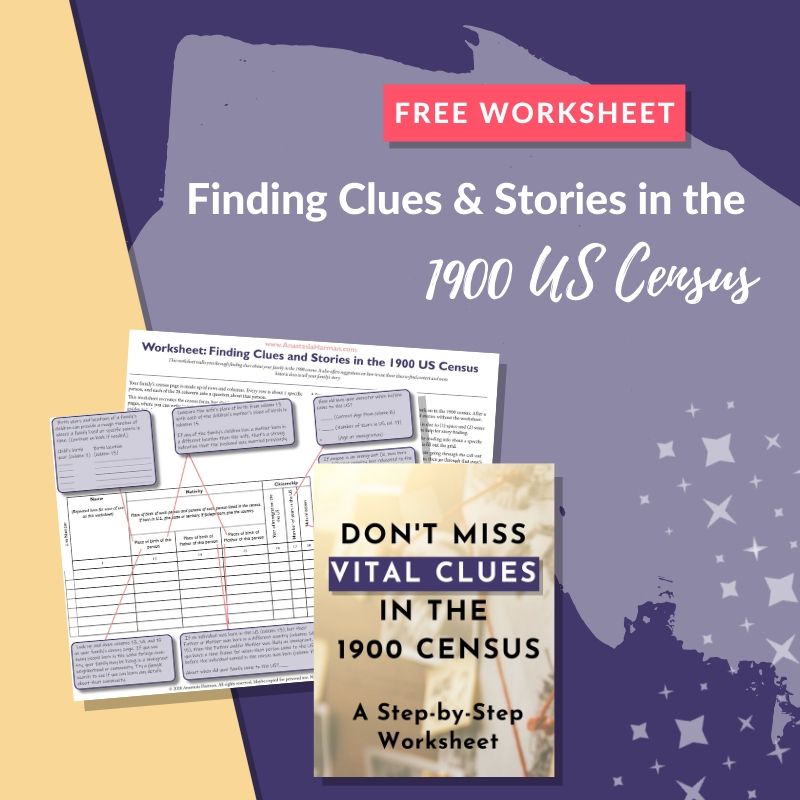
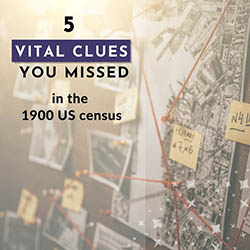
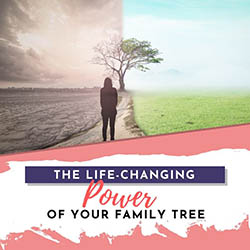
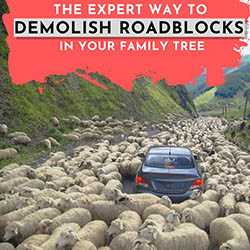

Interesting and nicely put together. I’ve been using some of these tips to locate where my great and great great grandparents lived in the US, as well as Canada and England.
That’s wonderful! I am SO glad you are finding these tips helpful in your research. That is my goal when I write these articles — to help people build their family tree. And thank you for your kind words 🙂
I wondered why you didn’t go back to the 1880 census Would you perhaps find the family together in Ohio
Hi Joyce, Going back to the 1880 census would definitely be a great lead to follow! In this family’s case, the girls’ parents didn’t marry until after 1880, so each of the parents are with their own parents in the 1880 census. It’s so frustratingly inconvenient that the 1890 census doesn’t exist any longer (for all intents and purposes). Especially for this family, the 1890 census could have been so helpful. The 20 year gap between 1880 and 1900 can be so challenging for research. For this specific article, I didn’t include all the research I did on this family — the article would be WAY too long if I did that! Ha ha 🙂 Thanks for reading and for reaching out!